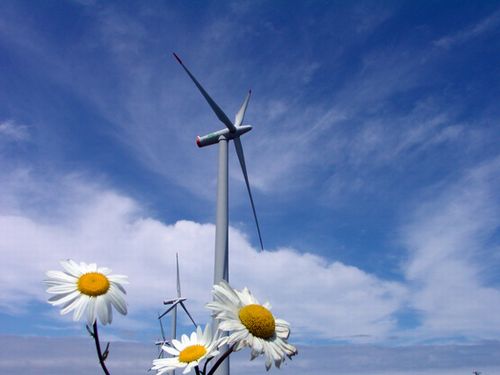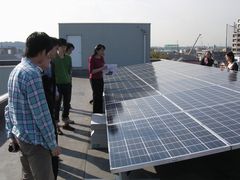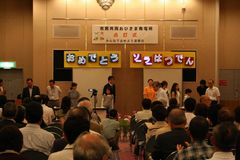December 17, 2008
Citizen-funded Renewable Energy Projects Gain Momentum in Japan
Keywords: Newsletter
JFS Newsletter No.75 (November 2008)

Community Wind Turbine "Hamakaze-chan": Copyright Hokkaido Green Fund
Introduction
Annual power generation in Japan in fiscal 2006 was about one million gigawatts per hour (GWh), generated by nuclear power (30%), petroleum (10%), coal (24%), natural gas (26%), hydropower (9%), and "new energy" (1%). The ratios of nuclear power and fossil fuels are significantly higher compared to the others, while renewable energy represents 10%. The "new energy" a unique category used by the Japanese government and includes power generated from waste, and fuel cell generation, as well as renewable energy sources including solar, wind, small and mid-scale hydropower (run-of-the-river power generation systems with a capacity of 1,000 kilowatts or less), geothermal, and biomass.
The government passed the Law Concerning Special Measures to Promote the Use of New Energy in June 1997 to ensure energy security and tackle global warming. Under the law, the government outlined a structure to promote new energy use by implementing a basic policy. It also set a goal to expand the ratio of new energy in the primary energy mix from about 1% in fiscal 1999 to about 3% by fiscal 2010.
The law requires Japanese electricity suppliers to expand new energy use by about 1%, which accounts for one-third of the goal of 3%. To achieve this, support at the introduction stage of power generation schemes is necessary, and so the Law on Special Measures Concerning New Energy Use by Electric Utilities, better known as the Japanese Renewable Portfolio Standard (RPS) Law, was implemented in June 2002. According to the law, electricity suppliers are allowed to purchase new energy from other power producers, as well as generate power using new energy on their own, to meet their legal obligations.
http://www.japanfs.org/en/pages/026899.html
The current ratio of new energy based power generation is only 1%, which is significantly lower than other countries. Even the RPS Law does not serve as a driving force to promote renewable energy use, as its target is only "1.63% of total power generation by 2014."
It was in this context that citizens launched initiatives to develop systems to promote natural energy by using local renewable energy sources for power generation. One of such initiatives, a citizens' movement to construct power plants, has arisen across the country. Construction expenses are funded by citizens, subsidies from the government, and the Green Power Fund. Following are some examples.
Citizen-funded Wind Turbines
As of January 2008, 11 citizens' wind turbines were in operation in Japan. The first wind power plant built with citizen funding, known as Hamakaze-chan, or "beach wind," with a rated output of 990 kilowatts (kW), was installed in Hamatonbetsu in Hokkaido, northern Japan, in September 2001. Since then, citizen-funded wind turbines have become popular not only in Hokkaido but also in the prefectures of Aomori, Akita, Chiba, and Ibaraki. The total output of these 11 wind turbines has reached 15,790 kW, and their annual power generation is roughly 40 million kWh, enough to serve the equivalent of 10,700 households, and estimated to reduce carbon dioxide (CO2) emissions by about 24,000 tons.
The main organization that helped with the installation of Hamakaze-chan was a nonprofit organization (NPO) called the Hokkaido Green Fund (HGF). Since 1999, the HGF has been working on the now-successful green electricity rates system, in which members pay an additional 5% of their monthly electricity bill to build a green fund. The green funds accumulated are then used to cover the installation cost of citizen-funded renewable energy power plants. In addition, the HGF established a system in which people other than NPO members and electricity customers of Hokkaido Electric Power Co. can donate money.
NGO Wins New Energy Award for Citizen-Funded Wind Power Plants
http://www.japanfs.org/en/pages/026037.html
The total project cost of Hamakaze-chan was about 0.2 billion yen (about U.S.$1.9 million). About 80% of that was paid with funds invested by citizens, rather than donations. The HGF expanded the system by establishing a company called the Japan Green Fund Co., in February 2003, allowing citizens from any part of Japan to invest.
Japan Green Fund For Renewable Energy Established
http://www.japanfs.org/en/pages/025143.html
The company is fully funded by an intermediate corporation, the Japan Green Fund. Two NPOs that were involved with establishing the corporation were the HGF and the Institute for Sustainable Energy Policies (ISEP), which provides resources and services to realize sustainable energy policies. The directors consist of representatives from citizen-funded renewable energy projects in different parts of Japan. The corporation built both a nationwide network and a system for monitoring the use of citizens' funds.
Institute for Sustainable Energy Policies
http://www.isep.or.jp/e/Eng_index.html
The most recently built wind power plant, Kanami-chan (1,650-kW), which means "wind wave," started operation in the city of Ishikari in Hokkaido in January 2008. A total of 470 shares were offered at 500,000 yen (about $4,762) per share, which amounted to 235 million yen ($2.24 million). As the total cost of the project came to 417 million yen ($3.97 million), the project was completed with a subsidy from the New Energy and Industrial Technology Development Organization (NEDO) for the promotion of local renewable energy in fiscal 2007.
Ohisama Energy Fund
An NPO named Minamishinshu Ohisama-Shinpo, or "Sun progress," has become a parent organization of the Ohisama Shinpo Energy Co., which was established in the city of Iida in Nagano Prefecture in December 2004 with the cooperation of ISEP. Ohisama Shinpo Energy aims to curb global warming and realize sustainable communities using local resources such as sunshine, heat, wind, forests, and other gifts from nature.
The company offered the Minamishinshu Ohisama Funds and received a full contribution of 201.5 million yen (about $1.92 million) from 460 people in May 2005. In addition to installing solar panels at 38 facilities, including kindergartens and community centers in the city of Iida, with a total generating capacity of 208 kW, the company promoted energy saving projects for public and private buildings. The total project cost of 360 million yen (about $3.43 million) was covered by the investments and a grant of 160 million yen (about $1.52 million) provided by the Ministry of the Environment, targeted for national projects that balance environmental protection and economic development. The company's dividend yield was just originally planned in June 2007.
One of the features of the fund is that it offers minimum investment amounts of as low as 100,000 yen (about $952) and 500,000 yen (about $4,762) per share. In November 2007, the Ohisama Energy Fund Co. was established, and it started soliciting for its investment fund, the Stop Global Warming Ohisama Fund, for a total investment of 462 million yen (about $4.4 million), and expanded the subjected area until the end of December 2008. As of November 7, it had already collected 337.8 million yen (about $3.22 million) in investments.
Citizen-Based Sustainable Energy Fund Launched to Stop Global Warming
http://www.japanfs.org/en/pages/026957.html
The prefectures of Nagano and Okayama plan to introduce a total of 1,108 kW of solar power capacity in 110 places, and the combined area of solar panels in the two prefectures will be almost as large as a football field. They will also invest a total of about 1.73 billion yen (about $16.5 million) in energy saving projects, etc.
Citizens' Joint Solar Power System in the City of Kawasaki

Solar Power System of Kawasaki
Copyright Act Kawasaki
In some cases, it is impossible to build a personal solar power system because of cost and location limitations, so some people thought they might be able to install a solar power system in a public building together with other citizens in their area. In this way, people could then learn more about global warming and eco-friendly lifestyles using the system as their base.
The Citizens' Joint Solar Power System, with an output capacity of 6.25 kW, was built on the site of the Kawasaki International Center in the city of Kawasaki, Kanagawa Prefecture, in August 2008. In November 2007, Kawasaki Action Plan Promotion Committee for Global Environmental Conservation, an NPO called Act Kawasaki, and local retailers jointly launched a project to collect donations of 1,000 yen (about $9.5) per share from citizens and businesses to fund the system. In the end it was independently funded by contributions from citizens of Kawasaki, without any subsidy from the city, together with a subsidy from the Green Power Fund and a bridge loan from ap bank, a non-profit organization that finances projects related to natural energy and the environment. The total cost was 8.5 million yen (about $80,950), of which 1.5 million yen ($14,290) was covered by citizen donations and 7 million yen ($66,660) by a subsidy from the Green Power Fund.
About ap bank
http://www.japanfs.org/en/pages/025659.html
http://www.japanfs.org/en/mailmagazine/newsletter/pages/027837.html

Countdown to start the system
Copyright Act Kawasaki
At a ceremony to mark the completion of the system, on August 24, 2008, various events were held such as a countdown to start the system, a water sprinkling event to cool down from the summer heat, lectures and panel discussions, and a summer anti-global warming campaign, taking the opportunity to raise citizens' awareness of global warming measures.
The Green Power Fund is funded by contributions from individuals and businesses as well as power companies. Contributors pay a certain amount, which is added to their electricity bill every month, while power companies pay a matching amount. The funds collected are managed by the local industrial advancement centers in each area, and then distributed as subsidies. At the end of 2006, the accumulated amount of funds available for subsidies was about 2.9 billion yen (about $27.6 million).
Conclusion
Japan has developed some of the most cutting-edge solar power technology in the world. It is also ranked among the best in terms of photovoltaic panel production. At the same time, however, Germany and other countries have surpassed its installed capacity of solar power systems. Germany, for instance, has promoted solar power largely due to its feed-in tariff (FIT) systems, but Japan has not yet established a market for it because it hasn't prepared a similar system. Moreover, it abolished the subsidy for households. These are the main two reasons solar power systems have not become more common in Japan, even though Japan has the technology and production capacity.
In order to change society at the local level, the phenomenon of citizens jointly planning and funding power plants is expected to play more of a role in expanding renewable energy use by strengthening people's willingness to support such projects and contribute funds. Building a system to promote new energy resources should be actively pursued in order to realize a low-carbon society.
(Written by Kiyoshi Koshiba)
Related
"JFS Newsletter"
- 'Good Companies in Japan' (Article No.4): 'Eightfold Satisfaction' Management for Everyone's Happiness
- "Nai-Mono-Wa-Nai": Ama Town's Concept of Sufficiency and Message to the World
- 'Yumekaze' Wind Turbine Project Connects Metro Consumers and Regional Producers: Seikatsu Club Consumers' Co-operative
- Shaping Japan's Energy toward 2050 Participating in the Round Table for Studying Energy Situations
- 'Good Companies in Japan' (Article No.3): Seeking Ways to Develop Societal Contribution along with Core Businesses


